|
FAQs about Non-Vertebrate Animal Identification
51
Related Articles: Marine Invertebrates, Marine Invertebrate Systems, Marine Invertebrate Compatibility,
Marine Invertebrate Disease,
Marine Invertebrate
Reproduction, Quarantine of Corals and
Invertebrates, Feeding
Reef Invertebrates, Lighting
Marine Invertebrates, Water Flow, How Much
is Enough,
Related FAQs: Non-Vert IDs 1, Non-Vert IDs 2, Non-Vert IDs 3, Non-Vert IDs 4, Non-Vert IDs 5, Non-Vert IDs 6, Non-Vert IDs 7, Non-Vert IDs 8, Non-Vert IDs 9, Non-Vert IDs 10, Non-Vert IDs 11, Non-Vert IDs 12, Non-Vert IDs 13, Non-Vert IDs 14, Non-Vert IDs 15, Non-Vert IDs 16, Non-Vert IDs 17, Non-Vert IDs 18, Non-Vert. ID 19, Non-Vert. ID 20, Non-Vert. ID 21, Non-Vert. ID 22, Non-Vert. ID 23, Non-Vert. ID 25, Non-Vert ID 26, Non-Vert ID 27, Non-Vert ID 28, Non-Vert ID 29, Non-Vert ID 30, Non-Vert ID 31, Non-Vert ID 32, Non-Vert 33, Non-Vert ID 34 Non-Vert ID 35, Non-Vert ID 36, Non-Vert ID 37, Non-Vert ID 38, Non-Vert ID 39, Non-Vert ID 40, Non-Vert ID 41, Non-Vert ID 42, Non-Vert ID 43, Non-Vert ID 44, Non-Vert ID 45, Non-Vert ID 46, Non-Vert ID 47, Non-Vert ID 48, Non-Vert ID 49, Non-Vert ID 50, Non-Vert ID 52, Non-Vert ID 53, Non-Vert ID 54, Non-Vert ID 55, Non-Vert ID 56,
Non-Vert ID
57, Non-Vert ID 58,
Non-Vert ID 59,
Non-Vert ID 60, Non-Vert ID 61,
& Marine Invertebrates, Marine Invert.s 2, Marine Invert.s 3, & FAQs about:
Marine Invertebrate Behavior,
Marine Invertebrate
Compatibility, Marine
Invertebrate Selection, Marine
Invertebrate Systems, Feeding
Reef Invertebrates, Marine
Invertebrate Disease, Marine
Invertebrate Reproduction, &
& LR
Life Identification, LR Hitchhiker ID
1, Anemone Identification,
Aiptasia
Identification, Aiptasia ID 2,
Worm Identification, Tubeworm ID, Polychaete Identification, Snail Identification, Marine Crab
Identification, Marine Invert.s 1,
Marine Invert.s 2, Marine Plankton,
|
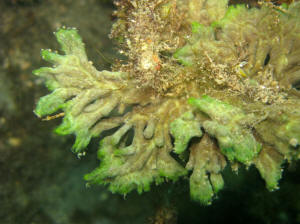
|
|
Unknown Organism: Fleshy Limpet: Lucapina sp. --
4/6/10
Hello WWM,
<Hello JM, Lynn here today.>
Attached, please find a couple of photos of an organism I have
not been able to identify at WWM or elsewhere.
<What you have is commonly called a 'Fleshy Limpet', a
species of Lucapina in the Family: Fissurellidae. Basically,
it's a Keyhole Limpet that's able to extend its soft
tissue mantle over the entire external surface of the shell
instead of just skirting the outside edges.>
It is a little bigger than a quarter and always stays on the
live-rock.
<Yes, they seem to prefer hard surfaces -- rockwork, glass,
and such.>
It moves frequently but very slowly.
<Yep>
Any information or links regarding ID, origin and tankmate
compatibility would be much appreciated.
<Lucapina spp. mostly hail from the Western Atlantic, from
Florida all the way to Brazil, and the Caribbean. They seem to be
omnivorous, mostly grazing microalgae as well as small sessile
invertebrates from the rocks (sponges, hydroids, etc.). However,
I have read about, and seen photos of, some individuals consuming
coral tissue. It's not a given that this will happen with
your individual, though, especially if you have a mature system
with a lot of microalgae, etc., on which it can feed. Many
hobbyists have kept these, in systems with corals, with no
problems. Personally, I'd go with an innocent until proven
guilty theory and leave in place until/unless I saw damage, but
it's up to you. For more information, please see the FAQ
about half-way down the following link titled 'Orange Frilly
Limpet - Lucapina aegis':
http://wetwebmedia.com/LimpetID1.htm
The individual shown looks very much like yours, but
unfortunately, I can't find any other corroborating photos on
the web, or in my reference books, to positively confirm that
what you have is Lucapina aegis. Don't get me wrong, I'm
not disputing what Anthony Calfo has stated at all. I'm just
not personally comfortable offering a solid ID on a snail without
having seen the actual shell under the mantle, knowing where the
snail came from, and having multiple sources to back up the ID.
Complicating matters is the fact that these guys can vary in
mantle and shell color to a surprising degree. The only thing
I'm sure of is that you have a species of Lucapina. Is it
Lucapina aegis? It could very well be. What's important to
note is that in Mr. Calfo's response, he recommends removing
this snail, but again, it's up to you. Here's a link that
reportedly shows a live specimen of Lucapina aegis (mantle not
fully extended): http://www.jaxshells.org/aegis1.htm
Several live specimens shown at the bottom of this page (the last
one 'may be Lucapina aegis'):
http://z14.invisionfree.com/Conchologist_Forum/index.php?s=3d4adb02ec7886bb7914cf50fad8f838&showtopic=984&st=0&#last
Dr. Shimek's article (see Fleshy Limpet section about 2/3 way
down the page: http://www.reefkeeping.com/issues/2004-06/rs/index.php
More FAQs at WWM: http://wetwebmedia.com/LimpetID2.htm
Thanks in advance!
<You're very welcome!>
JM
<Take care, LynnZ>
|
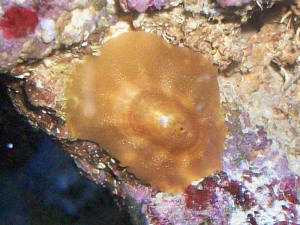 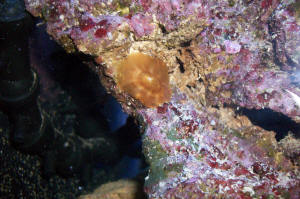 |
Re: Unknown Organism: Fleshy Limpet:
Lucapina sp. -- 4/6/10
LynnZ,
<Hi, JM!>
Thanks so much for that awesome and comprehensive response!!
<You're very welcome, it was a pleasure!>
I haven't noticed any bad behavior towards the rest of the
ecosystem so I am glad to say he stays.
<Yep, why not give the little fellow a chance? You can always
remove it later on if it starts nibbling on things it
shouldn't. In the meantime, you've got a nice little
algae-grazer and addition to the biodiversity of your
system.>
Thank again,
<Anytime>
JM
<Take care, LynnZ> |
|
Identify 4/3/10
Was hoping you might be able to help identify the little critter
pictured
here. My nephew caught it in a bucket on Miami Beach. Thanks
Mario Barroso
<Is Glaucus..., an Aeolid Nudibranch; likely
G. atlanticus:
http://en.wikipedia.org/wiki/Glaucus_atlanticus
Bob Fenner>
|
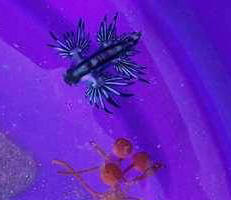 |
|
Critter ID 4/2/10
Hello everyone!
<Howdy Rhonda>
I'm almost afraid to ask but I found this weird moving spot
on one of my Alveopora stems. The thing moved pretty fast--there
was about 5 seconds between these photos. Any idea what
you're looking at? Is it horrible?
What should I do?
Thank you a million times.
Rhonda
<Looks to be a flatworm... not horrible if they are few.
Please read here:
http://wetwebmedia.com/flatworms.htm
and the linked Related FAQs files above on "control".
Bob Fenner>
|
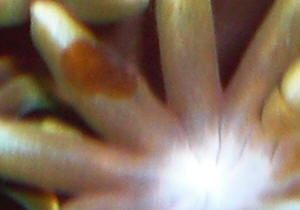 |
|
Turbo snail HHs -- 03/24/10
Hello from Portugal! I hope you can identify what is in my turbo
snail.
The photo goes in attachment.
Best regards,
Pedro
<Mmm, can't quite make it/these out... Could be other
snails/Gastropods... might be discrete bits/colonies of a sponge
of some sort... there are even other possibilities. If
they're not apparently harming the Turbo, I'd
ignore/enjoy them. Bob Fenner>
|
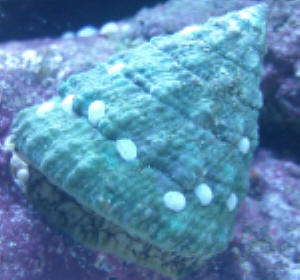
|
Re: turbo snail
3/24/10
Hi Bob,
> Those do look like gastropod eggs to me, too. Bogwood
in one of my tanks is covered with similar egg cases
produced by the various Nerite snails (see attached). For
some reason, the snails are picky, and only lay them on
wood, not plastic or glass.
> Cheers, Neale
<Thank you for this. BobF>
|
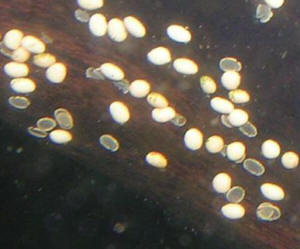 |
Re: More: re: turbo snail 3/24/10
Hi!!!
That's what I thought in the first place, but since I
only have got one Nerite I thought it was impossible for it
to mate.
Thank you for everything,
Pedro
<Perhaps you have more than one Nerite hidden somewhere?
Anyway, glad to have helped. Cheers, Neale.>
Comment on Re: More: re: turbo snail, Nerites
don't need "two to tango"
3/26/10
Good afternoon!
<Hello Audrey,>
Just a quick comment about the answer to the following
question Re: More: re: turbo snail 3/24/10 Nerites
don't need to mate to lay eggs. One lonely Nerite will
happily cover all suitable surfaces (wood, and occasionally
other snails' shells) with eggs.
<Very interesting. My specimens do seem to be mating
quite a lot of the time, but unlike the Clea helena or the
Tylomelania, I never find any baby Nerites. That's a
good thing or a bad thing, depending on your point of view,
I suppose. It does make them a great choice for tanks where
you don't want too many snails.>
They lay an incredible number of eggs each.
<Yes, they do!>
As usual, thank you so much for all your hard work,
Audrey
<Thanks for writing in! Cheers, Neale.>
|
|
little red dots 3/23/10
we have a salt water tank w/ little red dots moving about on the glass
& nobody seems to know what they are... Do u? please let us know...
TY
Brandy
<... read here: http://wetwebmedia.com/podidfaqs.htm
Bob Fenner>
|
Is This A Polyp?/Coral ID 3/23/10
Hello WWM Crew,
<Hello Heather>
I just started my first salt water tank a few weeks ago and have
been reading the Internet for all my questions and have found
most of my answers on your page. Anyways I bought more live rock
to make a shelf in my tank and when at my local fish store I saw
this yellowish (not solid yellow) nickle sized thing I know many
things can hatchhike
<hitchhike>
on the live rock as I found I have a few mini brittle starfish
from a different live rock (sorry got off track) so I asked the
<person> working at the store what it was and he said it
was a polyp. I went home to reaserch <research>
it to learn about it and can't find a polyp that looks like
the one in my tank and that's having me question it. I read
that polyp's are useual <usually> in groups and not
just one and cm.s in size and don't move.
This "polyp" that's in my tank is about a nickle
size round and a half in high <height> and moved from the
top of my shelf live rock to the under side of the live rock but
dose <does> show signs of being a polyp when the lights are
out it does release it tentecials <tentacles>. My question
is can you tell me if this sounds like a polyp and how I can go
about finding out what kind and if not what could it be?
<A well resolved photo is really needed to determine, although
not likely a polyp.>
Thank you very much
<You're welcome. James (Salty Dog)>
Heather
South Florida
Re Is This A Polyp?/Coral ID 3/23/10
Hello
<Hi Heather>
Lol... I'm so sorry about the spelling of the last email (and
this one maybe) as I was/am typing from small keys on my phone.
(not only but I'm not great at spelling...all I can do is
laugh at myself)
<No problem, and I likely would not go on the internet if I
had to do it by phone. Too small a screen/keys for me to be happy
with.>
My phone is my only way of getting online at this time and it
doesn't have a spellig/grammer <spelling/grammar> check
:(..... I'm very sorry. I can email a photo but being that my
phone is the only way to do so I am not sure what size the photo
will come to you as and don't know how to make it smaller if
needed. So I guess my next question is may I send the photo
anyways and see if it's ok?
<Sure, go ahead and send. Hopefully it will be clear enough to
hopefully ID.>
Very Sorry,
<No problem Heather. James (Salty Dog)>
Heather
|
|
Re Is This A Polyp?/Coral ID 3/23/10
James,
<Heather>
Here is this photo and I'm sorry but on my end it seems like
a big photo hopefully you can get it to finally help me....
<Photo is not clear/resolved enough for me to take a stab.
Perhaps Bob can make an educated ID of it. Do read the dailies
tomorrow for possible input on this ID.><<Just a guess
period, but considering where it's located, the shape,
colour... my bet is that this is a sponge. RMF>>
The "polyp" I am asking of is the yellowish thing
hanging from the rock in the middle of the photo and as I wrote
before it's a nickle in size round and about a half inch high
and it has moved again and it has squeezed itself between two
rocks and it almost looks like it's body is a jelly form.
Thank you for taking your time with me and understanding my
issue...;)
<No problem Heather, and tune in to the daily FAQ's
tomorrow. Go here and click on Today's FAQ's. Should be
posted around 2:00pm your time.
http://www.wetwebmedia.com/index.html
James (Salty Dog)>
Heather
|
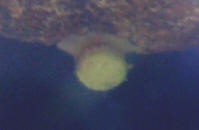 |
More Re: is this a polyp? 3/24/10
Hi Bob,
Geez, are there some species of sponge that are capable of
moving?
<Bizarre as it seems, there actually are! B>
Cheers,
James
Re Is This A Polyp?/Coral ID
3/23/10-3/24/10
Yes I will check it today. One more thing, <can> sponges
have tentacles that come out at night because this thing did?
<Bob's bet is that this is a sponge, so the tentacles
likely go along with the bet. Bob?><<Maybe summat living
inside the spaces in the sponge itself... Ophiuroids perhaps...
If it were mine, I'd reach in and give this ball a gentle
squeeze... I suspect a good deal of this mystery would be solved
thus. RMF>>
One again <again> thank you very much for your time!!!
;)
<You're welcome, Heather. James (Salty Dog)>
Heather
Re: More Re: is this a polyp? 3/25/10
<Bob's bet is that this is a sponge, so the tentacles
likely go along with the bet. Bob?><<Maybe summat living
inside the spaces in the sponge itself... Ophiuroids perhaps...
If it were mine, I'd reach in and give this ball a gentle
squeeze... I suspect a good deal of this mystery would be solved
thus. RMF>>
Thank you once again for your input.
James
<And you my friend. BobF>
Re Is This A Polyp?/Coral ID 3/23/10 - 3/24/10 -
3/25/10
Thank you once again for your input James. And Bob.
<You're welcome. James (Salty Dog)>
Re Is This A Polyp?/Coral ID 3/23/10 - 3/24/10 -
3/25/10
Wow really that sounds fun in a werid <weird>
way...lol...
<Mmm, now you got me thinking about Bob. Kind of akin to
squeezing black heads off someone's face:) But then again, I
have yet to meet a beer drinker who was weird.>
It has moved itself into a area of the tank where I can't
reach it. As soon as I can reach it with out moving my live rock
I will try that and let you know. Is it safe to touch with my
bare hands?
<Reportedly, there are some species of sponge that contain
neurotoxins, so to be safe, you may want to wear a pair of those
throw away surgical gloves.>
Once and again thank you very much
<You're welcome, Heather. James (Salty Dog)>
Re Is This A Polyp?/Coral ID 3/23/10 - 3/24/10 - 3/25/10
- 3/26/10
One more question by squeezing it will it release anything and
harm my fish that are in my tank?
<Bob mentioned "a gentle squeeze", and I'm sure
he would not suggest this if there was a downside. I'd leave
be and enjoy. James (Salty Dog)><<Correct.
RMF>>
|
Little White Tube Things... No Photo... feather duster?
3/20/10
Crew,
<Hi Teresa>
I have searched high and low but can't find anything pertaining to
these little white/cream things in the bottom of my tank.
<A photo would be most helpful.>
They are maybe a couple mm with a slight curve, like the way a banana
is shaped. On the inside of the curve is a light brown line running end
to end. They appear to be tubular. Can you tell me what these things
are?
<Just guessing here, you might be seeing the remnants of tiny tube
worm feather dusters, have a look on some of these pages:
http://www.wetwebmedia.com/feather.htm
http://www.wetwebmedia.com/feathwmidf2.htm
http://www.wetwebmedia.com/feathwmidf4.htm
http://www.wetwebmedia.com/featheridfaqs.htm
I hope these links are helpful, perhaps you'll see something
similar.>
Teresa
<Mich>
Once a Marine always a Marine. <<Aquarist?>>
<Semper fi>
Reef tank... org. ID...? 3/16/10
Simon,
<Hello Eric>
Thank you for the quick response. <That's fine> Unfortunately
nothing in the links you referred matched this particular
organism/organisms. I wish I had a way of posting a pic for ID but it
seems I've miss placed My camera. Thanks again for the help.
<No problem. I am not sure which posting you are referring to here,
could you include your previous correspondence and we might be able to
help further?>
Eric,
<Simon>
Hairy (maroon coloured, moving...) Nuisance, ID
3/15/10
I have something growing on/in my liverock that I can't identify.
It is maroon in color and looks almost like grass growing out of holes
in the liverock. I would normally take it to be some sort of algae, but
when disturbed it retracts into holes in the liverock. This makes me
think that it is some sort of anemone or worm. It grows in patches of
single strands with no noticeable body. Please help.
Derek
<Any chance of you sending along some well-resolved close up images?
BobF>
Re: Hairy Nuisance
Bob,
Unfortunately the combination of my archaic camera and my poor
photographic skills does not allow me to do that. I tried to
intelligently explain these things, but I don't think that my
explanation does them justice. There are basically dime sized patches
of maroonish "tentacles" coming out of holes in the liverock.
They don't extend more than 1/16th of an inch.
<Mmmm>
There are probably 3 or 4 "tentacles" coming out of each hole
with no noticeable body or mouth.
<Can you make out any lateral extensions from these processes? Am
given to a very preliminary guess that this may be a Hydropolyp
Hydrozoan... or even a bunch of Ophiuroids (Brittlestars)...>
I have poked at them with a bamboo skewer, and they retreat into the
pores of the liverock. They reappear maybe a minute after I stop
prodding. Am I correct in my assumption that since they rapidly retreat
they are not a form of algae?
<Yes>
I have tried to use WWM search as well as google search, but it is hard
to search for something that you don't know its name or even what
type of being it is. Hope you can help.
Derek
<As we both know, the breadth of life in the seas is vast... Do look
about to borrowing a camera... perhaps with its owner/photographer!
Please. BobF>
Book suggestions 2/28/10
Mr. Fenner,
<Edward>
Six months ago I started my first saltwater aquarium a 50 gallon
breeder tank and now I have nine fish, two shrimp, crabs, snails,
anemone, and some soft corals. I have read a number of other books
before I found your book The Conscientious Marine Aquarist revised and
updated second edition. I just read it cover-to-cover. There is one
thing I find lacking in all saltwater aquarium books, how to pronounce
the technical terms and scientific names of the animals. The only name
you show how to pronounce is cnidarians. I also find that at the few
aquarium society meetings I've attended the members have various
ways to pronounce names and terms as does the local fish store.
<Mmm>
I believe there is a market for a dictionary/glossary of terms and
names with pronunciation for the aquarium market. The author probably
would even set the standard on pronunciation of terms and scientific
names. Being a retired marketing consultant (computer industry) I would
guess nearly every aquatic club and 5 to 10% of their members would buy
a copy. Surely every local fish store would want a copy. Wouldn't
that outsell this book?
<I wish I could/would agree w/ you, but folks are wont to buy such
works I assure you>
There is one topic I find missing in the seven saltwater aquarium books
I've read; what hitchhikers can you expect to come along with live
rock and corals.
<Now THIS is a winner. A few of us/WWM had thought to produce a
title about such (cc'ed above)... Lynn Zurik in particular, has
become quite an adept at identifying and skillfully enumerating what
this myriad of "free" life is>
Looking at my tank I see enough life in there to write a PhD thesis.
Just from what I can see I have brittle stars (both tiny white ones and
one larger black one), bristle worms (maybe two types), tiny tube
worms, bivalves (I only find them after they have died), anemones (I
eradicated them), and crabs (not sure but they almost look like Emerald
crabs). I think all this came with live rock that I bought over six
months from the local fish store. All of the rock had been in the fish
store tanks for at least two weeks before I bought them. What I would
like to see is a chapter on these hitchhikers and which of them should
I be concerned with.
Thanks for a well written and informative book.
Regards,
Ed S
<Thank you for writing, sharing. Do please see/peruse our website,
WetWebMedia.com for much more.
Cheers, Bob Fenner>
|
Unknown Creature: Sea Cucumber -- 2/8/10
Hi everyone, I'm Mike in the UK.
<Hello Mike, I'm Lynn - near Seattle, Washington.>
I've had my first reef tank up and running for 20 weeks now
and to much success.
<Great>
I use your site often when help and views are needed as I
gradually learn on the lower end of a learning curve, and I find
it excellent. The reason I'm writing is that I'm trying
to identify a creature that came out for the first time yesterday
where I was able to take a photo (of which I have attached).
<Neat!>
The creature used to live in some porous rock and I could hardly
see it.
<That's fairly typical for these little creatures. They
like to hide within rock crevices.>
At times it would produce feather-like tendrils at the end that
protruded from the rock, so I assumed it was some sort of bristle
worm that was a filter feeder.
<I can understand why you'd think that. Those feathery
tendrils ('feeding tentacles') are indeed used for
filtering bits of particulate matter out of the water column. The
neat thing is that the tentacles work independently, instead of
as a group. When one captures a bit of food, it curls in on
itself, taking the food to the animal's mouth, then unfurls
back into its original position. What you have is a neat little
filter-feeding Holothuroid, or sea cucumber. The small
projections you see around the body of the animal are tube feet.
The Cuke uses them to secure itself within a hole/crevice, to
pick up bits of shell, etc., for camouflage, and for locomotion.
All in all, these are interesting and mostly harmless little
creatures. The only real worry with Cukes is their potential for
toxin release when threatened or dying (aka the dreaded 'Cuke
nuke'). Some are more toxic than others and risk increases
with large Cukes in small volumes of water. Thankfully, I
don't think you have too much to worry about with this
individual since it's so small. I would leave, and enjoy it.
Please see the FAQ's at the following link for more
information, particularly the one titled 'Anemone Id? Nope,
It's A Cuke! 8/10/07':
http://www.wetwebmedia.com/cukeidfaqs.htm >
However after seeing it this morning I'm not sure. It is
approx. 2.5 cm long and 0.5 cm in diameter. It reminds me of a
moth caterpillar.
<Me too. One thing I'd like to add that's completely
unsolicited is that I noticed in your photo that you've got
quite a growth of Caulerpa on your rocks. The stuff can be a
challenge to control but it can be done. Please see the following
links for more information re:
http://www.wetwebmedia.com/caulerpaalg.htm
http://www.wetwebmedia.com/caulerpacomp.htm >
I look forward to your reply and thanks for a great and
informative site.
<You're very welcome. Enjoy the Cuke! LynnZ>
|
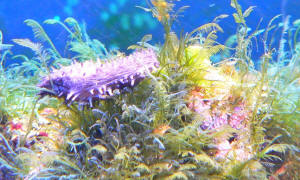 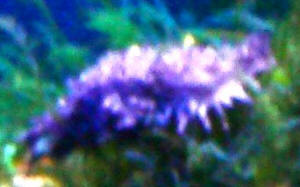 |
|
Re: Unknown Creature: Sea Cucumber --
2/9/10
Thanks Liz for the ID.
<You're very welcome, Mark. Heeee! Sorry, I couldn't
resist. I know your name is Michael. My first name is actually
Lynn, but no worries. Liz is close enough.>
I will read up on these creatures now. No wonder I could not ID
myself as I was looking for it under the illusion that it was
some kind of bristle worm.
<That's understandable. They're also occasionally
mistaken for Nudibranchs/sea slugs.>
As for the Caulerpa, it's gradually coming under control.
<Oh good! I've battled the stuff myself so I know what a
challenge it can be to eradicate.>
I manually remove some each week prior to water change and
regrowth is becoming less.
<Excellent. The trick is to get all those runners picked off
of the rocks. That's about a negative 150 on the fun-o-meter
scale!>
I've already battled and won through persistence and routine
maintenance an outbreak of red Cyano on the substrate and a green
hair-like Cyano that attached to my LR.
<Good for you! That stuff is the scourge of the hobby.>
The Caulerpa doesn't stress me half as much as those two
did.
<I can certainly understand that. One thing that could really
help here is a competing, favorable macro-algae kept in a
refugium/sump. I don't know if you have this, but if not,
it's worth considering.>
Thanks once again for the help :)
<It was a pleasure. Take care, LynnZ>
|
|
Re: name of algae, new... -- 02/08/10
Thank you for your quick answer. Can you help me again with this
one? It was taken Again in N-Sulawesi on a house rif in Lembeh
street.
<Ahh! Have spent quite a few vacations at KBR and Lembeh
Resort... there are now some 11 resorts being built and up there,
as well as some boats that come over from the Bunaken/Manado
side>
That same stuff I also found in the Philippines, a year ago, but
could not found out what is was.
Thanks again Bob.
Greetz Tineke
<I don't know what this is... looks like some sort of
Chlorophyte that is overgrowing a stony coral skeleton to me. Did
you happen to touch, move it with your hand that you recall?
BobF>
|
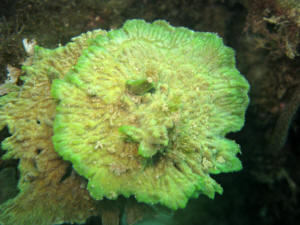  |
Re: name of algae --
02/08/10
Hay Bob....indeed it looks like overgrow of coral. I did found also
the one from the Philippines which I send you now. There is a very
close-up so maybe you can see what it is. But than the first
pictures I send you, there was one who looks like a flower
(886T-5221)...maybe this algae used base as a kind of stabilization
and grow bigger later. I didn't touched it but as I remember it
was on the edges not very *stony*
Greetz Tineke
<I'll be... you know, this close up reminds me of... some
sort of Ascidian colony; with some filamentous Green algae growing
at the apices of the branching. I do wish we had some on hand to
section and look at under a 'scope. Am going to ask LynnZ to
take a look here as well. BobF> |
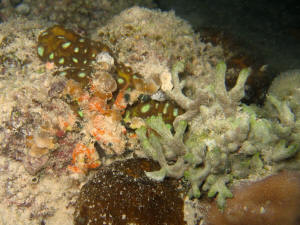 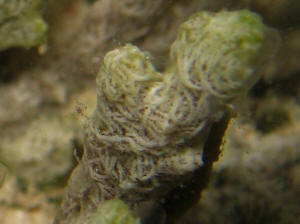 |
Re: name of algae -- 02/09/10
Thank you Bob, I wait till you get an answer. When ever I found
that again I will take a little piece with me...although it is
forbidden (just for sciences :)) unless LynnZ comes with the
name.
I look forwards to the answer!
<Me too Tineke>
Greetz from Holland
Tineke
<And back at you as they say, from S. California. BobF>
Re: Re: name of algae, perhaps a Poriferan --
2/10/10
Thank you Bob, I wait till you get an answer.
<<Hello Tineke and Bob, Lynn here today.>>
When ever I found that again I will take a little piece with
me...although it is forbidden (just for sciences :)) unless LynnZ
comes with the name.
<<Hmmm, I wish I could say that I have, but all I can offer
are more possibilities. One that comes to mind is that what
we're seeing isn't something actually overgrowing a coral
skeleton, but instead perhaps a branching Demosponge, order
Haplosclerida, all by itself. Perhaps the sponge is dead and has
a growth of some sort of filamentous algae covering the
openings/oscules at the tips? Apparently, these sponges are found
around the Philippines. I'd feel a whole lot more confident
though, if I could find and see a close-up of one, but I
haven't been successful. I know that these sponges are very
fibrous but I'm not sure if they're as ropy-looking as
what I see in your close-up photo.
If it's not a branching sponge, then I'm guessing
it's some sort of Chlorophyte or Phaeophyte overgrowing a
coral skeleton. What bothers me about this theory is that the
entire winding mass appears almost too smooth and web-like in its
covering of the skeleton. If this were an algae, it seems like
there would be stem ends extending here and there from the mass,
especially considering the fact that it winds around some fairly
narrow branches. I don't see any. Everything just seems a
little too close and compact.
One last possibility I looked into was an Ascidian/tunicate
overgrowing a coral skeleton. Unfortunately, I didn't have
much luck finding any suitable candidates. Of the three I
mentioned, I'm leaning towards the sponge, especially after
having seen the first link below (note the small oscules).
Sponge, order Haplosclerida. See photo under 'Sponge pictures
of week 3':
http://www.naturalsciences.be/active/expeditions/archive2005/patagonia2/page5
Another sponge in this order, found in Hawaii and the Philippines
(note branching variety):
http://www2.bishopmuseum.org/HBS/invertguide/species/gelliodes_fibrosa.htm
Ascidian overgrowing coral:
http://life.bio.sunysb.edu/marinebio/cr_36.jpg >
I look forwards to the answer!
<Me too Tineke>
<<Same here, Tineke>>
Greetz from Holland
Tineke
<And back at you as they say, from S. California. BobF>
<<And the same from Washington state as well. Take care,
LynnZ>>
>Well done, as usual, Lynn. BobF<
|
|
|

